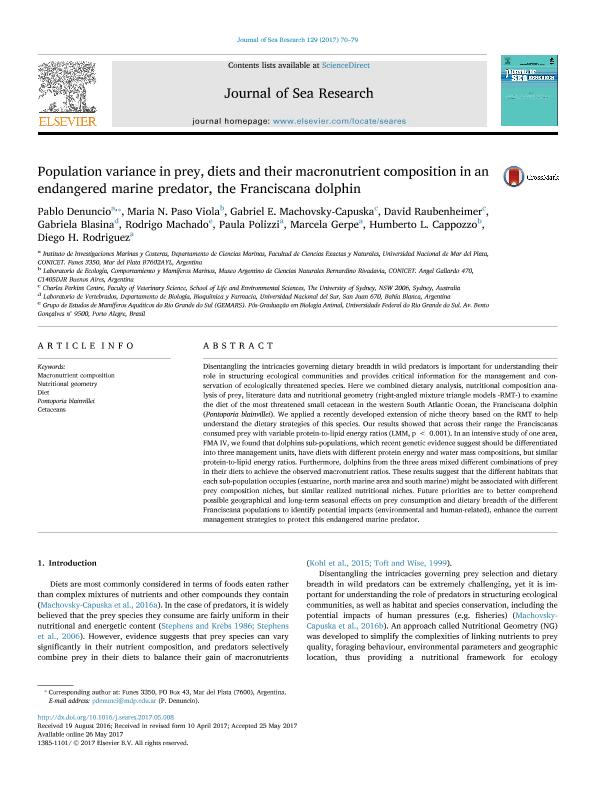Artículo
Population variance in prey, diets and their macronutrient composition in an endangered marine predator, the Franciscana dolphin
Denuncio, Pablo Ezequiel ; Paso Viola, María Natalia
; Paso Viola, María Natalia ; Machovsky Capuska, Gabriel E.; Raubenheimer, David; Blasina, Gabriela Elizabeth
; Machovsky Capuska, Gabriel E.; Raubenheimer, David; Blasina, Gabriela Elizabeth ; Machado, Rodrigo; Polizzi, Paula Sabrina
; Machado, Rodrigo; Polizzi, Paula Sabrina ; Gerpe, Marcela Silvia
; Gerpe, Marcela Silvia ; Cappozzo, Humberto Luis
; Cappozzo, Humberto Luis ; Rodriguez, Diego Horacio
; Rodriguez, Diego Horacio
 ; Paso Viola, María Natalia
; Paso Viola, María Natalia ; Machovsky Capuska, Gabriel E.; Raubenheimer, David; Blasina, Gabriela Elizabeth
; Machovsky Capuska, Gabriel E.; Raubenheimer, David; Blasina, Gabriela Elizabeth ; Machado, Rodrigo; Polizzi, Paula Sabrina
; Machado, Rodrigo; Polizzi, Paula Sabrina ; Gerpe, Marcela Silvia
; Gerpe, Marcela Silvia ; Cappozzo, Humberto Luis
; Cappozzo, Humberto Luis ; Rodriguez, Diego Horacio
; Rodriguez, Diego Horacio
Fecha de publicación:
26/11/2017
Editorial:
Elsevier Science
Revista:
Journal of Sea Research
ISSN:
1385-1101
e-ISSN:
1873-1414
Idioma:
Inglés
Tipo de recurso:
Artículo publicado
Clasificación temática:
Resumen
Disentangling the intricacies governing dietary breadth in wild predators is important for understanding their role in structuring ecological communities and provides critical information for the management and conservation of ecologically threatened species. Here we combined dietary analysis, nutritional composition analysis of prey, literature data and nutritional geometry (right-angled mixture triangle models -RMT-) to examine the diet of the most threatened small cetacean in the western South Atlantic Ocean, the Franciscana dolphin (Pontoporia blainvillei). We applied a recently developed extension of niche theory based on the RMT to help understand the dietary strategies of this species. Our results showed that across their range the Franciscanas consumed prey with variable protein-to-lipid energy ratios (LMM, p < 0.001). In an intensive study of one area, FMA IV, we found that dolphins sub-populations, which recent genetic evidence suggest should be differentiated into three management units, have diets with different protein energy and water mass compositions, but similar protein-to-lipid energy ratios. Furthermore, dolphins from the three areas mixed different combinations of prey in their diets to achieve the observed macronutrient ratios. These results suggest that the different habitats that each sub-population occupies (estuarine, north marine area and south marine) might be associated with different prey composition niches, but similar realized nutritional niches. Future priorities are to better comprehend possible geographical and long-term seasonal effects on prey consumption and dietary breadth of the different Franciscana populations to identify potential impacts (environmental and human-related), enhance the current management strategies to protect this endangered marine predator.
Archivos asociados
Licencia
Identificadores
Colecciones
Articulos(IIMYC)
Articulos de INSTITUTO DE INVESTIGACIONES MARINAS Y COSTERAS
Articulos de INSTITUTO DE INVESTIGACIONES MARINAS Y COSTERAS
Citación
Denuncio, Pablo Ezequiel; Paso Viola, María Natalia; Machovsky Capuska, Gabriel E.; Raubenheimer, David; Blasina, Gabriela Elizabeth; et al.; Population variance in prey, diets and their macronutrient composition in an endangered marine predator, the Franciscana dolphin; Elsevier Science; Journal of Sea Research; 129; 26-11-2017; 70-79
Compartir
Altmétricas



